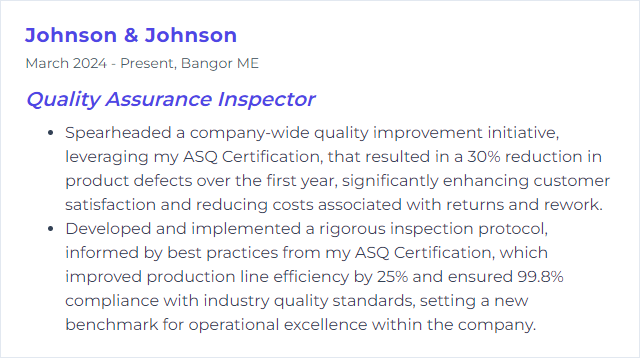Top 12 Quality Assurance Inspector Skills to Put on Your Resume
In today's competitive job market, standing out as a Quality Assurance Inspector means showing a sharp blend of technical know-how, relentless attention to detail, and crisp communication on your resume. Put your strongest skills front and center and hiring managers notice. Quickly.
Quality Assurance Inspector Skills
- ISO 9001
- Six Sigma
- Lean Manufacturing
- SAP ERP
- Minitab
- Quality Control Standards
- Statistical Process Control (SPC)
- Root Cause Analysis
- GMP Compliance
- CAPA (Corrective and Preventive Action)
- Inspection Coordination
- ASQ Certification
1. ISO 9001
ISO 9001 sets the requirements for a quality management system (QMS). It helps organizations deliver consistent products and services that meet customer and regulatory expectations. For a Quality Assurance Inspector, it frames how to monitor, document, and improve quality and process performance.
Why It's Important
ISO 9001 matters because it anchors consistent practices, clear documentation, risk-based thinking, and continual improvement. For inspectors, it defines what “good” looks like, so checks, records, and improvements align with recognized global standards.
How to Improve ISO 9001 Skills
Know the requirements: Study the clauses, the process approach, and the seven quality management principles. Understand risk-based thinking and how it affects inspection planning.
Train and refresh: Take periodic training on auditing, document control, nonconformance handling, and corrective action.
Tighten process controls: Map processes, define inputs/outputs, assign owners, and standardize work. Build quality gates where defects like to hide.
Audit with purpose: Run regular internal audits. Write precise findings. Verify effectiveness, not just completion, of corrective actions.
Use PDCA relentlessly: Plan, do, check, act—then loop again. Small, steady improvements compound.
Listen to customers: Capture feedback, complaints, and returns data. Turn that into preventive actions and refined specs.
Track KPIs: Monitor scrap, rework, first-pass yield, and on-time corrective actions. Review trends and react fast.
Build habits around these and your QMS won’t just comply—it will breathe.
How to Display ISO 9001 Skills on Your Resume
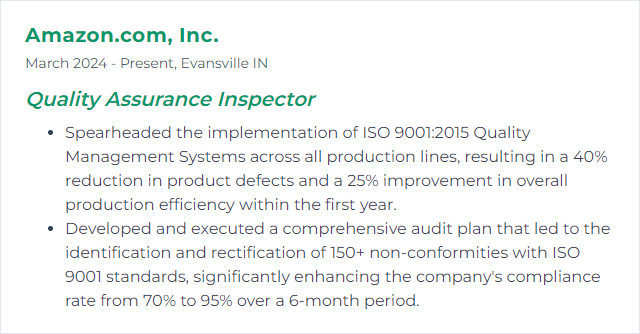
2. Six Sigma
Six Sigma is a data-driven method for reducing defects and variation. It blends tools and rigor to improve quality and throughput—daily bread for inspectors guarding product excellence.
Why It's Important
It sharpens how you define problems, measure what matters, analyze root causes, improve processes, and control results. Fewer surprises. More consistent outcomes.
How to Improve Six Sigma Skills
Live the DMAIC cycle: Define clearly, measure reliably, analyze statistically, improve pragmatically, control persistently.
Use the tools: Control charts, capability analysis, FMEA, Pareto, fishbone, regression. Pick the right tool, not every tool.
Quantify variation: Separate common cause from special cause. Act only when the data says “move.”
Run real projects: Target chronic pain points—scrap, rework, delays. Show baseline, intervention, and sustained gains.
Earn certification: Green Belt or Black Belt adds structure and credibility to your practice.
Share wins: Standardize what worked. Spread it to sister lines or plants.
How to Display Six Sigma Skills on Your Resume

3. Lean Manufacturing
Lean Manufacturing removes waste while protecting value. It boosts flow, quality, and speed—prime territory for inspectors focused on prevention over detection.
Why It's Important
Lean makes processes stable and visual. That means clearer standards, fewer defects, and faster feedback when things drift.
How to Improve Lean Manufacturing Skills
Kaizen mindset: Encourage small, daily fixes. Capture ideas from the floor and act on them quickly.
5S the workplace: Sort, set in order, shine, standardize, sustain. Good housekeeping is quiet quality control.
Poka‑yoke: Error-proof where mistakes are easy. Guides, sensors, interlocks—cheap insurance.
Quality at the source: Build checks into each step. Stop the line for abnormalities. Don’t pass defects forward.
Value stream map: See the whole flow, cut delays, expose bottlenecks, and tighten handoffs.
Root cause discipline: Use 5 Whys and cause‑and‑effect diagrams to fix causes, not symptoms.
How to Display Lean Manufacturing Skills on Your Resume
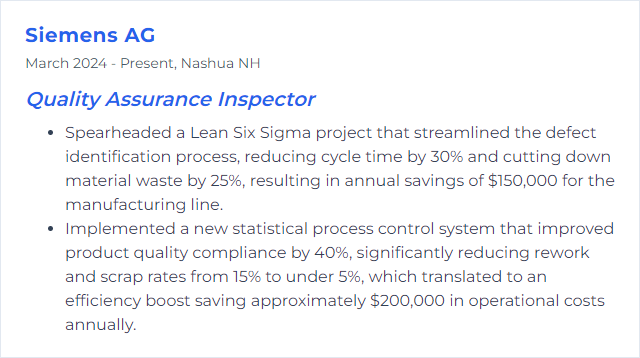
4. SAP ERP
SAP ERP integrates core business processes. For inspectors, the Quality Management (QM) capabilities centralize inspections, sampling, usage decisions, nonconformances, and corrective actions.
Why It's Important
Single source of truth. Real-time visibility. Traceability from supplier to shipment. Fewer blind spots, tighter control.
How to Improve SAP ERP Skills
Harden master data: Inspection plans, sampling procedures, characteristics, and codes—clean and current.
Standardize inspection lots: Automate triggers at goods receipt, in‑process, and final inspections. Define clear acceptance criteria.
Streamline notifications: Configure defect codes, tasks, and responsibilities. Track cycle time and overdue items.
Tune reports and dashboards: Build views for defect trends, supplier performance, and VOE (verification of effectiveness).
Train users: Short, role‑based training and job aids. Less friction, fewer data errors.
How to Display SAP ERP Skills on Your Resume

5. Minitab
Minitab is statistical software used to analyze quality data, spot trends, validate improvements, and control processes with rigor.
Why It's Important
It turns raw measurements into decisions. Control charts, capability, DOE, and hypothesis tests—evidence, not hunches.
How to Improve Minitab Skills
Master the essentials: Control charts by data type, normality checks, capability (Cp/Cpk/Pp/Ppk), and confidence intervals.
Use Assistant and templates: Guided workflows help you choose the right analysis and interpret results cleanly.
Automate repeat work: Create macros or execs for recurring analyses. Save time, reduce mistakes.
Clean your data: Validate measurement systems (MSA), address outliers thoughtfully, and document assumptions.
Practice with real cases: Analyze past defects, cycle time, and yield data. Reproduce wins and codify learnings.
How to Display Minitab Skills on Your Resume

6. Quality Control Standards
Quality Control Standards set the benchmarks products and processes must meet. They guide inspection, testing, and acceptance so output is reliable and consistent.
Why It's Important
Standards reduce ambiguity. Inspectors compare against known criteria, detect nonconformances early, and prevent expensive fallout.
How to Improve Quality Control Standards Skills
Clarify specifications: Tolerances, methods, sampling plans, and acceptance criteria—precise and visible at the point of use.
Standardize methods: Work instructions and checklists that reflect reality on the floor. Keep them version‑controlled.
Leverage technology: Digital checklists, photo evidence, automated gauges, and QMS workflows to tighten compliance.
Audit and calibrate: Verify process adherence and measurement equipment regularly. Fix drift before it bites.
Supplier alignment: Share standards upstream. Qualify, monitor, and improve together.
Continuous improvement: Review defects and escape points. Update standards when evidence demands it.
How to Display Quality Control Standards Skills on Your Resume
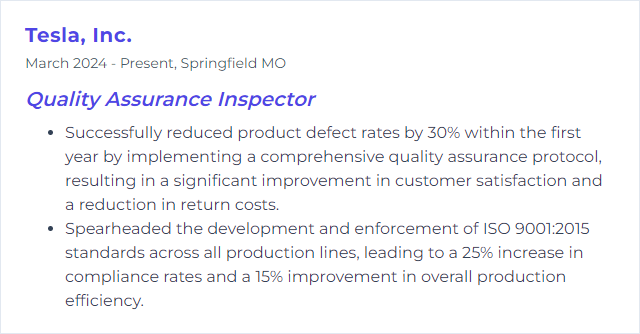
7. Statistical Process Control (SPC)
SPC uses statistics to monitor and control process behavior. It shows when a process is stable and when it’s signaling for help.
Why It's Important
Early detection of shifts and trends prevents defects, reduces waste, and keeps production humming within capability.
How to Improve Statistical Process Control (SPC) Skills
Pick the right chart: X‑bar/R, I‑MR, p, np, c, u—match chart to data and subgrouping.
Establish control limits properly: Use stable historical data. Recalculate only when justified.
React with rules: Define rules for out‑of‑control signals and train teams to act the same way, every time.
Instrument and sample well: Reliable measurements and sensible sampling frequency beat noisy data and guesswork.
Close the loop: Investigate signals, implement fixes, verify effectiveness, and document what changed.
How to Display Statistical Process Control (SPC) Skills on Your Resume
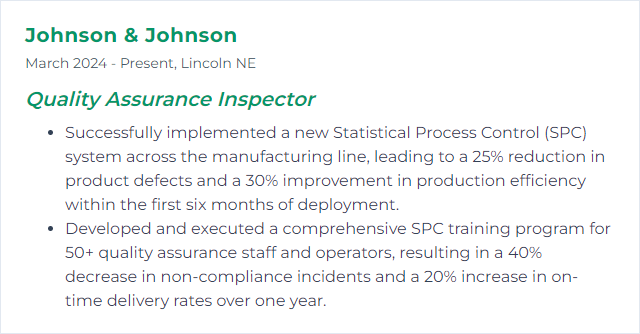
8. Root Cause Analysis
Root Cause Analysis (RCA) is a structured way to find why a problem really happened, then prevent the encore.
Why It's Important
Fixing symptoms is whack‑a‑mole. RCA kills the cause so quality improves and stays improved.
How to Improve Root Cause Analysis Skills
Define the problem precisely: Who, what, when, where, how much. No fuzzy edges.
Collect the right evidence: Data, photos, timelines, process maps, and voice of the customer. Facts first.
Analyze with structure: 5 Whys, fishbone, fault tree, or Pareto to prioritize and drill down.
Validate the cause: Test hypotheses. Reproduce the failure if safe. Correlation isn’t causation.
Correct and prevent: Implement targeted fixes. Add controls to stop recurrence. Assign owners and deadlines.
Verify effectiveness: Check results over time. If the signal returns, revisit the cause.
Document and share: Capture learnings, update standards, and train those affected.
How to Display Root Cause Analysis Skills on Your Resume
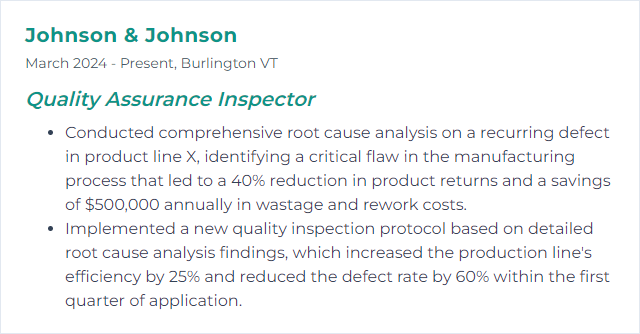
9. GMP Compliance
GMP (Good Manufacturing Practice) ensures products are consistently made and controlled to quality and safety standards. Inspectors are the stewards of proof.
Why It's Important
In regulated industries, GMP is non‑negotiable. It reduces patient and consumer risk beyond what end‑testing can catch.
How to Improve GMP Compliance Skills
Strengthen documentation: Clear SOPs, good records (ALCOA+), timely entries, controlled changes.
Train continuously: Role‑specific onboarding, periodic refreshers, and practical check‑offs on the floor.
Audit often: Internal audits that probe deeply. Address observations fast with robust CAPA and VOE.
Validate critical systems: Cleaning, equipment, computerized systems, and utilities—qualified and maintained.
Foster speak‑up culture: Encourage deviation reporting and near‑misses without fear.
Watch suppliers: Qualify, audit, and monitor suppliers. Quality agreements that spell out expectations.
How to Display GMP Compliance Skills on Your Resume
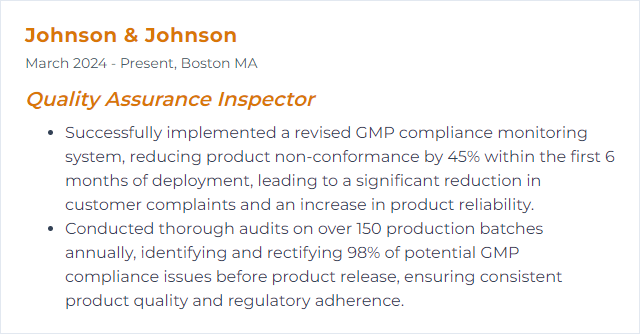
10. CAPA (Corrective and Preventive Action)
CAPA is the system for fixing what went wrong (corrective) and stopping it from happening again (preventive). Structured, traceable, effective.
Why It's Important
It turns problems into improvements and keeps regulators, customers, and teams confident that issues don’t boomerang.
How to Improve CAPA (Corrective and Preventive Action) Skills
Start with a sharp problem statement: Scope, impact, and evidence clearly defined.
Do real RCA: Use systematic methods and verify the root cause before acting.
Plan SMART actions: Specific, measurable, achievable, relevant, and time‑bound—both corrective and preventive.
Implement with ownership: Assign accountable owners, due dates, and needed resources.
Verify effectiveness (VOE): Check that the action truly eliminated recurrence. Document the proof.
Standardize the gain: Update procedures, train staff, and adjust controls so improvements stick.
Review the system: Periodically assess CAPA cycle time, backlog, and repeat issues.
How to Display CAPA (Corrective and Preventive Action) Skills on Your Resume
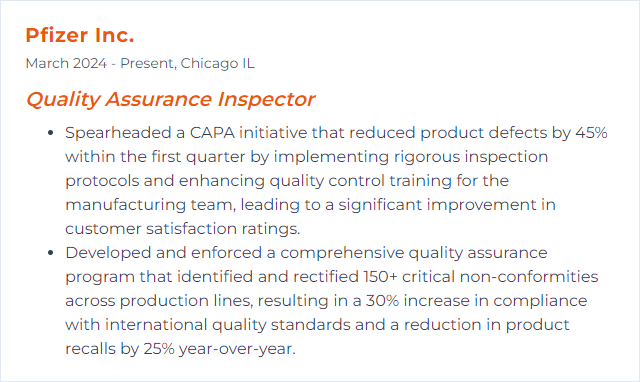
11. Inspection Coordination
Inspection Coordination is organizing, scheduling, and overseeing inspections so products and processes meet requirements without chaos or collisions.
Why It's Important
Good coordination cuts delays, reduces rework, and keeps everyone aligned on what’s inspected, when, and by whom.
How to Improve Inspection Coordination Skills
Clear communication channels: Real‑time updates, single source schedules, and defined points of contact.
Smart scheduling: Balance capacity, priorities, and changeovers. Lock in windows and honor them.
Standardize checklists: Consistent criteria and evidence capture. Photos, measurements, acceptance rules.
Digitize the flow: Use tools for requests, tracking, and reporting. Minimize manual handoffs.
Close feedback loops: Share inspection findings fast with production, engineering, and suppliers.
Train for consistency: Calibrate inspectors, align on interpretations, and run periodic inter‑rater checks.
How to Display Inspection Coordination Skills on Your Resume
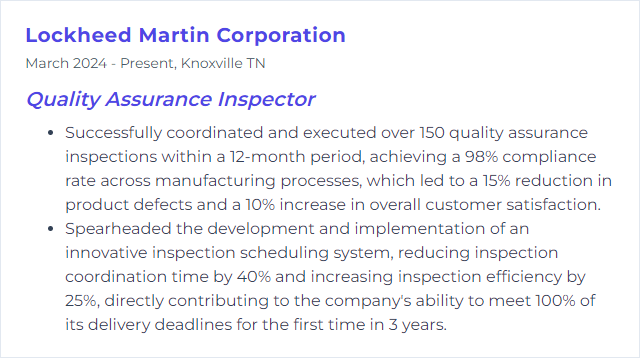
12. ASQ Certification
ASQ Certification recognizes demonstrated competence in quality disciplines. It signals commitment, depth, and credibility.
Why It's Important
It validates your skill set to employers, opens doors to higher-impact work, and ties you into a professional community and body of knowledge.
How to Improve ASQ Certification Skills
Select the right path: CQI, CQA, CQE, CSSGB/CSSBB—align to your role and goals.
Study the Body of Knowledge: Break it into weekly chunks. Practice weak areas more than strong ones.
Get hands‑on: Apply concepts at work—audits, CAPA, SPC, MSA. Experience cements theory.
Practice exams: Simulate timing and conditions. Review misses and adjust study plans.
Join peers: Study groups and local sections help with nuance and motivation.
Keep current: After certification, maintain CEUs and keep sharpening your toolkit.
How to Display ASQ Certification Skills on Your Resume
